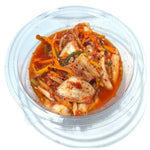Pork Kimchi Soup is an irresistible culinary experience thanks to the spicy and tangy flavor of kimchi. This hot dish is ideal for those who want to improve their cooking skills quickly and easily. Follow this recipe presented by Hello Asia for a soup that is as delicious as it is quick to prepare.
Quick summary
Ingredients needed
- Pork belly: 200g
- Kimchi: 200g
- Classic seasonings: A pinch (sugar/salt/ground pepper)

How to Make Pork Kimchi Soup
Step 1: Prepare the ingredients
Take 200g of pork belly, wash it thoroughly in water, then cut it into small pieces. Take 200g of kimchi, cut it into small sections about the size of a finger, reserving the kimchi juice in a separate bowl.

Step 2: Stir-fry the pork and kimchi
Turn on the heat, add the pork with half a teaspoon of salt and half a teaspoon of pepper, then stir-fry for about 2 to 3 minutes until the meat is browned. Then add the kimchi, mix well for 2 minutes so that the pork and kimchi infuse with flavors.

Step 3: Cook the soup
Add 80ml of kimchi juice and 250ml of warm water. After about 7 to 10 minutes, the soup will start to boil. Reduce the heat and cover the pot to cook for another 15 minutes. Then, uncover, add a teaspoon of sugar to adjust the seasoning to your taste, and turn off the heat.

Result
Your kimchi soup is ready! Warm and appetizing with bright colors, this soup combines the acidity, sweetness and spiciness characteristic of kimchi, combined with the tenderness of pork belly. You can enjoy this soup with rice or noodles , which makes it even tastier. Although this dish is delicious, it is best to avoid consuming it for breakfast, as spicy foods may not be suitable for your stomach and digestive system.

How to choose fresh ingredients
How to Choose Fresh Pork Belly
Choose pork belly pieces that are light pink in color. When you touch the meat, it should have some elasticity and not be soft. Choose pieces of meat with a balanced proportion of meat and fat to avoid the meat being too greasy or too dry. Do not buy meat that is purple in color or has bruises and an unpleasant odor. This could indicate that the meat is no longer fresh or comes from a sick animal.
How to choose a good kimchi
Choose kimchi that has a natural red-orange color and a pleasant smell from spices such as ginger, onion, garlic, etc. Good kimchi has a sweet, spicy, and salty taste from natural ingredients, and the cabbage leaves should remain crispy. Avoid kimchi that has an abnormal smell, as it could be moldy or over-fermented, which could be bad for your digestive system. If you are buying ready-made kimchi, choose reliable brands, check the expiration date, and make sure the packaging is intact. To be safe and economical, you can also make your own kimchi at home for long-term use.

Introduction to Korean Kimchi
Korean Kimchi - A Culinary and Cultural Treasure
Kimchi, a traditional Korean dish, has transcended national borders to become a global culinary icon. With its unique flavors, kimchi is a staple of every Korean meal, carrying deep cultural and historical significance. This article provides an overview of kimchi, its history, preparation, and its important role in Korean life and culture.
History of creation
Kimchi originated over 2,000 years ago, born out of the need to preserve vegetables during the harsh Korean winters. Initially, the dish was limited to pickling vegetables such as Chinese cabbage or radish, to use them during the months when vegetables could not be grown. Over time, kimchi evolved with the addition of various spices and fermentation techniques, creating a wide variety of variations of the dish.
The introduction of chili pepper in the 16th century, after its arrival from Japan, significantly changed the flavor of kimchi. The chili pepper not only added a spicy note but also gave the preparation its characteristic red color, which has become the central element of modern kimchi.
Preparing Kimchi
The traditional method of making kimchi is quite simple but requires precision and patience. The main ingredients of kimchi are Chinese cabbage, salt, chili pepper, garlic, ginger, and other vegetables such as radish and green onions. Some types of kimchi add special ingredients such as fermented seafood (salted shrimp, fermented anchovies), bringing a unique flavor.
The preparation process begins by salting the cabbage for several hours to soften it and remove excess water. Then, spices, including chili powder, garlic, ginger, and fish sauce, are mixed and applied to each cabbage leaf. Once spiced, the cabbage is placed in an airtight jar to ferment naturally for a few days to several weeks, depending on the temperature and individual preferences for acidity.
Kimchi in Korean Culture
Kimchi is not just a dish, it is a distinctive cultural symbol of Korea. Koreans consider kimchi to be the “soul” of their meals, present at every table, whether it is a family meal or a celebration. Each Korean family has its own kimchi recipe, passed down from generation to generation, creating a unique bond between family members.
In addition, Korea celebrates the tradition of "Kimjang" - the collective preparation of kimchi in winter. Kimjang is not only used to store provisions for the winter, but also to bring communities together to share joy and solidarity.
Health benefits
Kimchi is a fermented food rich in nutrients and probiotics, which is excellent for digestion. The probiotics from the fermentation process help balance the intestinal flora, thus aiding digestion and strengthening the immune system. In addition, kimchi contains many vitamins and minerals, such as vitamin C, vitamin A and antioxidants, which help the body fight free radicals.





